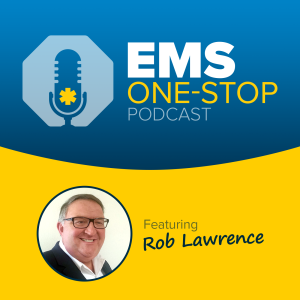EMS One-Stop
Explore the forefront of EMS leadership with Rob Lawrence on the ”EMS One-Stop” Podcast. Tackling critical issues like staffing, service delivery and operational challenges, each episode delves into the latest in patient care enhancement, EMS technology advancements; and emerging trends like AI, telehealth, quality improvement and alternate destinations with industry experts. Rob Lawrence brings to the table his extensive expertise from decades of service spanning the American Ambulance Association, AIMHI, Richmond Ambulance Authority, Pro EMS, Prodigy EMS Education and the East Anglian Ambulance NHS Trust. Stay informed with the latest EMS industry news, organizational updates and inspiring agency success stories. Tune in to the ”EMS One-Stop” Podcast for a deep dive into the challenges and triumphs of EMS leadership in today’s dynamic prehospital care landscape.
Episodes

Thursday Jul 03, 2025
Thursday Jul 03, 2025
In this high-impact edition of the EMS One-Stop podcast, host Rob Lawrence sits down with EMS influencer and educator Jimmy Apple, known widely across platforms as The EMS Avenger. With nearly 70,000 followers on TikTok and a growing presence on Instagram and Facebook, Jimmy has mastered the art of compressing complex clinical topics into digestible, engaging content.
| More: What the EMS Counts Act means for dual-role EMS providers
In this conversation, Rob pulls back the curtain on the man behind the mobile screen — exploring Jimmy's journey from electrician to pediatric critical care paramedic, and now, one of EMS's most watched and listened-to voices.
Listeners will gain deep insight into Jimmy’s origin story, his social media strategies, his refusal to let bad information go unchallenged, and his passionate belief that “Saving lives begins with kindness.” The pair also tackle:
Content creation advice for EMS agencies
The challenges of tone and accuracy in short-form video
How to maintain compassion in the face of a toxic work culture
This episode is part masterclass in communication, part call to action for the future of EMS — and all heart.
Memorable quotes from Jimmy Apple: The EMS Avenger
“Saving lives begins with kindness. That is my motto, it is my philosophy.”
“You have to package something down to its bare essence … there's some nuance lost, but you have seconds to keep people's attention.”
“My goals going forward are to support people who are acting in good faith while correcting the misinformation.”
“Generally speaking, you will draw the engagement that you're looking for. If you're putting out content in good faith, you'll get good faith engagement.”
“We are responsible for ourselves and how we respond … and I believe we need to respond to everything that is happening in the world today with kindness.”
Episode timeline
00:54 – Rob introduces Jimmy Apple, aka the EMS Avenger
01:20 – Jimmy’s background: from electrician to EMS
03:30 – The grandfather conversation that changed his life
04:50 – How pathophysiology sparked a love for learning
05:40 – Birth of the EMS Avenger: from student favorite to TikTok influencer
06:55 – Ginger Locke’s advice that redirected Jimmy’s podcast path
08:04 – Compressing content: "from textbook to bumper sticker"
10:00 – The content hook: “Are we getting rid of normal saline?”
11:00 – How Jimmy selects topics: research, news, curiosity and requests
13:00 – Hot topics in EMS: cricothyrotomy, TXA, ketamine, provider safety
14:40 – Rob discusses EMSIntel.org and ambulance theft data
16:00 – Can EMS agencies do what Jimmy does? The risks and the realities
18:30 – "Stop the finger": creating content that captures attention
20:00 – Rob on the risks of public messaging and backlash
21:00 – Calling out misinformation: the line between education and shame
23:00 – Jimmy’s growing reach across TikTok, Instagram and Facebook
24:45 – Managing Facebook’s deeper comments and nuanced conversations
26:45 – Jimmy’s rule: “Engage only with good faith”
27:50 – Final thought: EMS must rediscover kindness
29:00 – Closing remarks and where to follow Jimmy Apple online
Additional resources
Connect with Jimmy Apple, better known as The EMS Avenger:
TikTok — Jimmy offers short-form, evidence-based EMS content here: @emsavenger
Instagram — Engage with in-depth reels, visuals, and professional updates: @emsavenger
X (formerly Twitter) — Follow EMS commentary, conversation, and boosts: @EMSAvenger
Facebook — Join the group for discussions and shared insights: EMS Avenger community
Apple Podcasts — Listen to “EMS Avenger: 20 Minutes to Save the World”: Weekly podcast series
AAA & AIMHI EMS Media Log: EMS Intel
Enjoying the show? Contact the EMS One-Stop team at editor@EMS1.com to share ideas, suggestions and feedback.

Monday Jun 30, 2025
Monday Jun 30, 2025
In this special crossover edition of EMS One-Stop and The Bridge Podcast from the Kentucky Office of Rural Health, host Amelia Holliday leads the conversation, joined by Scott Helle, rural project manager at KORH; and Rob Lawrence, host of EMS One-Stop and EMS leader.
Recorded live at the 2025 Kentucky EMS Leadership Academy, this episode explores the evolution, design and impact of the Leadership Academy on Kentucky’s rural EMS landscape. The discussion dives into the Academy’s origins, structure, statewide reach and its mission to prepare the next generation of EMS leaders in some of the most resource-challenged communities in the country.
From the realities of low-volume, underfunded rural services, to the inspiring stories of leadership growth and resilience, this episode offers a thoughtful examination of the challenges facing EMS in Kentucky and beyond. Rob reflects on leadership principles drawn from his military and EMS career, while Scott provides a blueprint for how to build and sustain EMS talent in small communities. Together with Amelia’s thoughtful moderation, this episode highlights how mentorship, structured learning and network-building are transforming rural EMS leadership — one cohort at a time.
Additional resources
The Bridge Podcast (Contains additional discussion)
Center of Excellence in Rural Health: Established to address health disparities in rural Kentucky
Asking the big questions: Industry leaders weigh in on celebrating EMS Week amidst the forces shaping the EMS landscape
Cultivating the next generation of EMS: Leadership development, emotional intelligence and the importance of mentorship
Memorable quotes
“We’re promoting people above their level of competency — not because they’re not good, but because we haven’t prepared them for what’s next.” — Rob Lawrence
“We saw early on that EMS professionals were great at clinical care, but we were missing the leadership piece.” — Scott Helle
“Effective communication is the core of good leadership. You can’t lead without it.” — Amelia Holliday
“My six principles: pride, integrity, learning, humor, service and courage. They guide everything I do.” — Rob Lawrence
“It costs money to build people. That’s why we provide this Academy at no cost to participants.” — Scott Helle
“It’s hard to run EMS in a state where many counties don’t even have a tax base to support it.” — Scott Helle
“You’re always leading. Once you start, it never stops. People are always watching and listening.” — Rob Lawrence
“We’re not just building leaders — we’re building mentors, networks and future change-makers.” — Scott Helle
“Nobody becomes a good leader because they want power. The best leaders are those who understand the responsibility.” — Amelia Holliday
Episode timeline
00:18 – Introduction to the Kentucky Leadership Academy and crossover with The Bridge Podcast
02:29 – How the Academy was formed and why it was needed
05:00 – Structure of the Academy, application process and regional representation
08:11 – EMS 2050, developing next-gen leaders, and avoiding the Peter Principle
11:00 – The importance of non-clinical leadership education
13:36 – Funding challenges in rural EMS, tax base realities and sustainable operations
17:41 – Rural EMS dynamics, local politics and the true cost of readiness
21:25 – Hospital closures and extended transport times — national rural EMS challenges
24:11 – Leadership is constant: visible, energetic and principle-driven
28:14 – Rob’s military leadership values and the weight of being observed
32:35 – Leadership as service and the power of building trust within teams
34:58 – Rob’s group dynamics “icebreaker” exercise and lessons on leadership styles
39:33 – Mentorship benefits both ways: mentees gain confidence, mentors renew purpose
44:49 – Academy success stories and graduates becoming leaders elsewhere in EMS
46:44 – Closing comments and podcast wrap-up with Amelia and Rob
Rate and review the EMS One-Stop podcast
Enjoying the show? Contact the EMS One-Stop team at editor@EMS1.com to share ideas, suggestions and feedback.

Monday Jun 30, 2025
Monday Jun 30, 2025
In this episode of the EMS One-Stop podcast, host Rob Lawrence sits down with Danielle Thomas, chief operating officer, Lifeline EMS of Los Angeles, to explore how her team is harnessing “actual intelligence” — through a proprietary, closed-source AI platform called InCheck — to solve a perennial EMS headache: information overload. Thomas explains how embedding agency-specific protocols, an 800-page policy manual and multi-language translation into a single voice-activated app gives every crew member a “mentor in their pocket,” shrinking cognitive load, sharpening clinical decision-making and smoothing onboarding during the critical first 80 hours of employment.
| More: From 73 to 33 minutes: How Sacramento reinvented patient offload times
The conversation ranges from her move from Boston to California and the regulatory culture shock that followed, to Lifeline’s recent CAAS accreditation push and the wider potential of AI-driven tools to boost recruitment, retention, compliance and patient safety.
In the second half, Rob and Danielle expanded the conversation from tools to leadership strategy, focusing on how EMS agencies can better support staff in high-pressure, multi-jurisdictional environments.
Thomas shares how her team tackled issues like protocol confusion, inconsistent policy knowledge and language barriers — not by adding more training sessions, but by rethinking how information is delivered, accessed and retained on the front lines. She emphasizes the importance of aligning education with the way today’s workforce learns, communicates and engages — especially during the critical first days of employment.
The episode closes with a preview of Danielle’s upcoming AAA conference presentation with Carly Strong, which challenges perceptions of gender in EMS leadership and spotlights the untapped potential of inclusive, thoughtful organizational development.
Memorable quotes
“If you can, as the leader in an EMS organization, figure out how to enhance not only that first 80 hours, but that team member experience.” — Danielle Thomas
“As everybody listening knows, I'm sure that every new policy probably has somebody's secret name attached to it because of what happened.” — Rob Lawrence
“It honestly solves our recruitment and retention issues because they want to come to work.” — Danielle Thomas
“I happen to believe that [AI is] an on-the-train or under at the moment kind of thing … we now have to move forward. It's part of our life. We have to embrace it and we have to employ it.” — Rob Lawrence
“The left coast is more highly regulated and so I was not used to the labor laws in California and I was not used to the way that the local EMS authorities work.” — Danielle Thomas
“I think every company I've worked at that that was a thing and so we had to create a solution to the problem we had, which was information overload.” — Danielle Thomas
Episode timeline
01:25 – Welcome to Danielle Thomas
02:56 – East-to-West move and California’s regulatory maze
4:12 – Lifeline EMS footprint across Los Angeles, Orange and Riverside Counties
6:27 – The policy-overload dilemma in multi-county operations
10:01 – InCheck: turning 800 pages into actionable intel
14:53 – From AI skeptic to evangelist — programming county-specific protocols
18:30 – Five operating modes explained (Rampart, Angel, Nova, L-Chat Narrative)
28:00 – 100-language instant translation with Nova
34:51 – Building the tool in-house; cost and compliance advantages
38:43 – Preview of AAA Conference session, “Just one of the guys”
41:33 – Final takeaways: enhancing the first 80 hours and keeping crews engaged
42:44 – Closing remarks
Rate and review the EMS One-Stop podcast
Enjoying the show? Please take a moment to rate and review us on Apple Podcasts. Contact the EMS One-Stop team at editor@EMS1.com to share ideas, suggestions and feedback. Listen on Apple Podcasts, Amazon Music, Spotify and RSS feed.

Thursday Jun 12, 2025
Thursday Jun 12, 2025
In this international edition of the EMS One-Stop podcast, host Rob Lawrence welcomes Lewis Andrews, the chief operating officer of the United Kingdom’s College of Paramedics, for an insightful discussion on two major topics shaping global paramedicine.
First up is International Paramedic Day, taking place on July 8, 2025. Now in its third year, the day honors the contribution of paramedics across the world and draws its inspiration from the birthday of Dominique-Jean Larrey, the father of battlefield ambulance care. Lewis explains how the day has grown from 50 initial partners to over 150 global organizations, with this year’s theme being “Unity and community.” The day aims to raise awareness of the profession, share innovations and bring together the global paramedic community.
MORE | How community paramedicine is thriving in the UK: Dr. Linda Dykes and Rom Duckworth discuss trans-Atlantic lessons in emergency management
In the second half of the show, Lewis delves into the structure and significance of the College of Paramedics, which represents nearly half of the UK’s registered paramedics. He describes how the UK paramedic profession is regulated and protected by law, with a rigorous educational pathway that now includes the potential for prescribing paramedics and direct-to-primary-care tracks.
Rob and Lewis explore how paramedics in the UK are increasingly working beyond emergency ambulances — in GP surgeries, urgent care centers and academic roles. Their conversation offers a rich comparison point for U.S. EMS leaders seeking to elevate paramedicine through autonomy, education and broader clinical roles.
Memorable quotes
“This is not a commercial platform — this is about us celebrating us.” — Lewis Andrews, on the ethos of International Paramedic Day
“Let’s not reinvent the wheel, but let’s look at what the wheel is for the environment that it’s required to roll in.” — Lewis Andrews, on global EMS collaboration
“The title ‘paramedic’ is protected by law in the UK — you can’t simply do a first aid course and call yourself one.” — Rob Lawrence
“Autonomy — in a word — that’s what makes a prescribing paramedic.” — Lewis Andrews, on expanding paramedic roles
“We’re also promoting the profession to those who don’t yet know they want to be in the profession.” — Lewis Andrews, on recruitment and professional identity
“We have a career framework … that actually shows that you can develop from that day one newly qualified right through to a consultant paramedic, chief paramedic, director, professor.” — Lewis Andrews
Episode timeline
00:55 – Introduction to International Paramedic Day (IPD) and its origins
02:17 – Why July 8 was chosen: Dominique-Jean Larrey’s birthday
03:02 – Growth of IPD from 50 to over 150 partners
05:06 – 2025 theme: “Unity and community” and sub-objectives
06:45 – How to participate: share stories, use hashtags (#UnityAndCommunity and #IPD2025), connect globally
08:58 – The global nature of IPD and U.S. partners’ involvement
11:25 – Promoting awareness and the importance of celebrating paramedics
12:50 – Part 2 — The role of the College of Paramedics
14:09 – Overview of College functions: CPD, representation, research, advocacy
18:15 – Registration with HCPC, protected title and the regulator’s role
21:12 – Paramedic education in the UK: degree pathways, demand and cost
23:46 – Discussion on streaming directly into primary care roles
27:09 – Career framework: from graduate paramedic to chief paramedic/professor
30:16 – Prescribing paramedics: autonomy and improved patient experience
33:08 – Recap and call to action: visit www.internationalparamedicsday.com
34:17 – Like, subscribe and engage
ADDITIONAL RESOURCES
International Paramedics Day Resources
UK College of Paramedics
The standards of proficiency for paramedics
RATE & REVIEW
Enjoying the show? Contact the EMS One-Stop team at editor@EMS1.com to share ideas, suggestions and feedback.

Thursday Jun 05, 2025
Thursday Jun 05, 2025
In this vital episode of EMS One-Stop, host Rob Lawrence is joined by Matt Zavadsky and attorney Doug Wolfberg of Page, Wolfberg & Wirth for a deep-dive into three financial flashpoints currently impacting EMS.
First, the trio unpack the launch of the new PWW|AG/EMS|MC EMS Financial Index, a quarterly report leveraging billing and revenue cycle data from over 1,500 agencies nationwide. This unprecedented benchmarking tool allows EMS leaders to measure performance against regional and national trends, uncovering actionable insights into billing strategies, reimbursement rates, payer mixes and the economics of service delivery. It’s a critical step in helping agencies justify their value and improve their financial sustainability.
Next, the discussion turns to MedPAC — the Medicare Payment Advisory Commission — and its controversial response to cost data submitted by ambulance services under the CMS Ground Ambulance Data Collection System. Doug Wolfberg explains how MedPAC discarded over half of the data, labeling higher-cost services — often rural or government-run — as outliers. This move could justify lower or stagnant Medicare fee increases, potentially devastating many providers.
Finally, attention shifts to the “One Big Beautiful Bill” moving through Congress and now on its way to the Senate that would eliminate or severely restrict enhanced Medicaid funding mechanisms, such as supplemental payments and provider taxes. If passed, this legislation would reduce reimbursement for millions of transports, triggering funding crises across EMS systems — particularly in states like California and Illinois. The episode delivers a clear message: EMS leaders must prepare, advocate and act now.
Episode timeline
00:41 – Rob introduces the three main topics: the PWW|AG/EMS|MC EMS Financial Index, MedPAC’s response to ambulance data and a major federal bill impacting Medicaid
01:59 – Part 1 — PWW|AG/EMS|MC Financial Index
03:37 – Matt explains that the index is built using data from over 1,500 EMS agencies via EMS|MC
05:43 – The importance of regional benchmarking
08:22 – First major finding: dramatic variation in ALS billing rates across regions
09:30 – Key insight: agencies that bill more tend to collect more revenue — agencies are encouraged to determine their true cost of service and align billing accordingly
12:37 – Collection percentage is debunked as a misleading metric; focus should be on dollars collected
15:36 – ALS vs. BLS billing levels explained, with a look ahead to Q2’s emergency-only data set
18:48 – How EMS agencies can better engage with insurers to cover non-transport and MIH services
20:46 – Part 2 — MedPAC
22:24 – Doug outlines how MedPAC discarded over half of the reported ambulance cost data
25:00 – Explanation of which data was discarded and why — primarily high-cost, rural and government-based services
28:22 – Doug asserts MedPAC is using cherry-picked data to suppress reimbursement increases
30:10 – Rob and Doug emphasize that EMS gave MedPAC quality input, but MedPAC is producing garbage output
32:08 – Doug outlines what MedPAC will do next and what EMS leaders must do in response
34:40 – Strong call to action: educate Congress, use real CMS data and don’t accept MedPAC’s narrative
36:59 – Doug emphasizes the importance of evidence-based deployment strategies for financial sustainability
37:31 – Part 3 — “One Big Beautiful Bill”
38:19 – Matt outlines how the bill would drastically limit Medicaid supplemental payments
39:43 – Federal/state Medicaid match rates explained with California as an example
42:51 – The looming reckoning: local governments may have to pay to maintain current EMS service levels
46:02 – Matt warns that the bill could trigger PAYGO cuts to Medicare as well
47:16 – Agencies are urged to plan now, talk to their communities and adjust operations
48:06 – Doug adds that pressure on U.S. senators, especially in red states, could still influence the bill
51:26 – Close and call to action
Final takeaway
This episode underscores that EMS cannot remain reactive — leaders must proactively use data, engage legislators and educate their communities on the true cost of care. The EMS Financial Index, the MedPAC dismissal, and the pending bill all point to a critical need for informed, strategic advocacy.

Tuesday May 27, 2025
Tuesday May 27, 2025
In this episode of the EMS One-Stop podcast, host Rob Lawrence sits down with returning guest Chief Robbie MacCue of Colonie EMS (New York) to explore the transformative potential of the Safe Streets and Roads for All (SS4A) federal grant program.
Funded by the Infrastructure Investment and Jobs Act, SS4A aims to prevent roadway fatalities and enhance post-crash care. With $5 billion available nationwide and $900 million still on the table for FY25, this conversation is a call to action for EMS agencies across the country.
Chief MacCue shares the story of how his department, in collaboration with neighboring EMS and police agencies, secured $2.4 million in SS4A funding for a project focused on innovative vehicle alert systems, prehospital health information exchange and groundwork for whole blood deployment.
From demystifying the grant application to defining success metrics and compliance reporting, this episode breaks it all down — turning policy into practice, and complexity into impact.
Memorable quotes
“I was pretty taken back by the statistic that 40% of these patients were alive when EMS arrived and later died. Those are patients that are talking to us that are no longer living after a crash.” — Robbie MacCue
“This isn’t free money. It comes with reporting requirements, match funding and responsibility — but there’s help out there, and it’s absolutely worth it.” — Robbie MacCue
“Our goal is to go upstream to the source of the problem. How do we stop the bleeding? How do we stop some of these accidents from actually happening?” — Robbie MacCue
“We put a two-page narrative together that generated a $3,000,000 regional application … based on simple principles about statistics.” — Robbie MacCue
“Post-crash care is definitely a missing element in the Safe System Approach … and EMS needs to be part of the solution, not just the response.” — Robbie MacCue
“You don’t have to have all the solutions right away. You just have to have the initiative to get with other like-minded people.” — Robbie MacCue
“This project isn’t just for crashes. It will also help us with high-utilizer patients and improve reimbursement accuracy by connecting data silos.” — Robbie MacCue
“Somebody emailed me in the week to say that the EMS One-Stop podcast is the podcast that’s able to turn a very complex EMS topic into a car bumper sticker. So there you go. If we’re doing that and we can achieve that, then we’re getting somewhere.” — Rob Lawrence
Episode timeline
00:00-02:00 – Intro to SS4A and the scale of available funding ($5B)
02:00-04:00 – Why post-crash care matters: 42% of patients alive at EMS arrival die later
04:00-07:00 – How Colonie EMS discovered and approached the SS4A opportunity
07:00-10:00 – Building a regional grant application and tripling the funding
10:00-13:30 – Overview of the proposed project – transponder tech, health information exchange and whole blood
13:30-17:00 – Specific technology being explored and integration challenges
17:00-20:00 – Working with MPOs, consultants and navigating acronyms
20:00-25:00 – Finding the 20% match, leveraging in-kind contributions and funding timelines
25:00-30:00 – Federal reporting requirements and budgeting with SF-424A
30:00-35:00 – The big goal: Closing the outcome data loop and EMS-hospital data sharing
35:00-40:00 – Measuring success, from whole blood to vehicle alerts
40:00-42:30 – Robbie’s final advice: “Don’t be intimidated — reach out and apply.”
ADDITIONAL RESOURCES
SS4A Application Portal & Resources: Safe Streets and Roads for All (SS4A) Grant Program | US Department of Transportation
NHTSA’s Office of Emergency Medical Services | EMS.gov
Lexipol Grants Support
Metropolitan Planning Organizations (MPOs) database

Tuesday May 13, 2025
Tuesday May 13, 2025
In this episode of the EMS One-Stop podcast, host Rob Lawrence kicks off a special series spotlighting national EMS associations, beginning with a deep dive into the EMS Personnel Licensure Interstate CompAct (REPLICA). His guest, Donnie Woodyard Jr., executive director, Interstate Commission for EMS Personnel Practice, brings decades of EMS experience and leadership to the table to demystify what the EMS Compact is, how it operates, and why it matters to the profession today. From improving workforce mobility to protecting public safety during disasters, Woodyard Jr. provides clarity on this critical multi-state agreement.
The conversation covers everything from how EMS Compact came to be, to the significance of national registry standards, disaster response logistics, interstate licensure, and even leadership lessons from Woodyard Jr.’s latest book project, “Leadership in action: The Wisdom and stories of EMS innovators”. Whether you're a field provider or policymaker, this episode is a must-listen for understanding how collaborative legislation can shape the future of EMS.
In the episode, Woodyard Jr. candidly addresses the ongoing debate in North Carolina over transitioning from a state-only EMS certification exam to exclusive use of the National Registry. Woodyard Jr., while respectful of North Carolina’s long-standing EMS tradition, emphasizes the importance of national consistency. He acknowledged that the proposed legislation needed amendments, particularly around grandfathering existing providers, but stood firm in his belief that a single, legally defensible national standard is essential for provider mobility and professional integrity. Drawing on real-world examples, Woodyard Jr. described how providers are often caught off guard when relocating — only to discover their credentials aren't accepted elsewhere. “Maintaining a state-only exam is harmful to individuals,” he said, calling for unified testing standards that support workforce movement and strengthens the profession nationwide.
Memorable quotes from Donnie Woodyard Jr
“Every EMT and paramedic in the United States should go through a fingerprint background check. You know, babysitters have to do it. Teachers have to do it. EMS personnel absolutely should do it.”
“Maintaining a state-only exam is harmful to individuals. It limits their mobility.”
“When you waive that requirement for licensure, you actually are removing essential elements of public protection and accountability.”
Timeline
00:21 – Rob introduces the series on national EMS associations and welcomes Donnie Woodyard, Jr.
01:55 – Woodyard, Jr.shares his EMS journey from volunteer in Virginia to international disaster medicine and state leadership
03:41 – What is the EMS Compact and how does it work?
06:38 – Challenges of multistate EMS licensing pre-Compact
08:00 – Explaining the driver’s license analogy and compact accountability
11:17 – EMAC vs. EMS Compact for disaster response and liability concerns
15:31 – National Registry and grandfathering provisions
17:30 – Arkansas joins as the 25th compact state
18:56 – Model legislation and how states join the compact
21:22 – What REPLICA stands for and its legislative origin
22:20 – What California (and other non-compact states) should consider
24:33 – National Registry debate: North Carolina’s challenges and Woodyard, Jr.’s response
27:52 – Mobility, workforce attrition and job-sharing innovation
30:11 – The Commission and national EMS-coordinated database
35:17 – Final thoughts on fragmentation, collaboration and EMS unity
36:41 – Woodyard, Jr.’s leadership book, EMS charity support and Secretary Panetta’s forward
41:08 – Closing remarks and contact information
Additional resources
Learn more about the EMS Compact
“Leadership in action: The Wisdom and stories of EMS innovators”, by Donnie Woodyard Jr.
“The future of emergency medical services: Artificial intelligence, technology & innovation”, by Donnie Woodyard Jr.

Wednesday May 07, 2025
Wednesday May 07, 2025
In this special data-driven edition of the EMS One-Stop podcast, host Rob Lawrence is joined by Dr. Brent Myers, chief medical officer, ESO, and Dr. Remle Crowe, ESO’s director of clinical and operational research, to unpack the newly released 2025 ESO EMS Index.
This annual report provides a powerful, real-world snapshot of national EMS trends — drawing on more than 14 million anonymized records to surface opportunities for clinical and operational improvement.
The conversation dives into key metrics that move beyond response times and into areas like pain management, opioid overdoses, airway confirmation, obstetric emergencies, whole blood use, pediatric behavioral health and high-utilization patient populations.
Throughout the episode, Drs. Myers and Crowe share the motivation behind each metric, explain how the data was gathered and analyzed, and reflect on how EMS agencies can use these insights to guide better care delivery and system design. From confronting equity in pain management, to pushing forward innovations like buprenorphine administration and whole blood programs, this is a compelling call to turn data into meaningful change.
Timeline
01:08 – Overview of the ESO EMS Index and its intent
02:59 – Origins of the report and data methodology
05:46 – Database scale: 14M+ records, 3,000+ agencies
07:14 – Metric 1: Pain management for long bone fractures
10:53 – Documentation, AI in EMS, and future documentation tools
14:30 – Metric 2: Suspected opioid overdose and buprenorphine use
18:51 – Best practices, COWS scoring, and naloxone delivery strategy
21:31 – Metric 3: Invasive airway confirmation using waveform capnography
28:06 – Metric 4: Obstetric emergencies (postpartum hemorrhage & hypertension)
34:34 – Metric 5: Prehospital whole blood surveillance
40:22 – Metric 6: Pediatric behavioral health and substance use disorder cases
44:54 – Metric 7: High utilization patient group (HUG)
52:48 – Final thoughts, calls to action, and Rob’s reflections
55:47 – Episode wrap-up and subscription reminder

Thursday May 01, 2025
Thursday May 01, 2025
In this episode of EMS One-Stop, host Rob Lawrence is joined by Dr. Christine Carico and Dr. Matt Levy to discuss the peer-reviewed paper, “Nationwide Trends in Prehospital Blood Product Use After Injury.” The paper, published in “Transfusion” in April 2025, explores the use of blood products in prehospital trauma care.
Despite the proven benefits of blood transfusion in the field, their research uncovers the alarming reality that less than 1% of eligible patients receive prehospital blood products. This conversation dives into the study’s methodology, key findings and the significant barriers EMS systems face in implementing blood transfusion protocols. The discussion also touches on the evolving role of EMS in trauma care, regional variations in blood product access, and the future of prehospital blood transfusion programs.
Dr. Carico and Dr. Levy break down their work and reflect on the data, explaining how the study used National Emergency Medical Services Information System (NEMSIS) data to identify trauma patients who would have benefited from blood transfusions.
The episode delves into the operational challenges EMS systems face in obtaining and administering blood products in the field, the financial and logistical obstacles, and the potential life-saving impact of more widespread adoption of these protocols.
Timeline
00:00 – Intro and welcome: Rob Lawrence introduces Dr. Matt Levy and Dr. Christine Carico, setting up the discussion on prehospital blood product use
03:00 – Study overview: Dr. Carico explains the methodology of the study, focusing on the use of NEMSIS data and the inclusion criteria for the patient population
07:00 – Key findings: Dr. Carico reveals the key findings of the paper, including the low percentage of eligible patients receiving prehospital blood products
11:00 – Barriers to implementation: Dr. Levy discusses the main barriers to the widespread implementation of blood transfusion protocols in the field, including access to blood, logistics and training
17:00 – Regional variations: The speakers touch on the regional disparities in blood product availability and the differences in protocols across the country
23:00 – Data challenges: Dr. Levy and Dr. Carico discuss the challenges related to data accuracy, particularly in terms of blood product documentation
27:00 – Cost and reimbursement: Dr. Levy addresses the financial aspects of blood product programs, including cost, reimbursement challenges and funding opportunities
32:00 – The future of blood transfusion in EMS: Dr. Levy envisions the future of prehospital blood transfusion programs, including the potential for shelf-stable blood products and regional blood supply systems
37:00 – Closing thoughts: Both guests offer their final thoughts on the importance of continued research and data collection, and the need for EMS to embrace a more integrated role in acute care
Additional whole blood resources
Carico C, Annesi C, Clay Mann N, Levy MJ, et al. “Nationwide trends in prehospital blood product use after injury,” 2025. Transfusion – Wiley Online Library
Tracking the whole blood landscape as updated guidelines allow EMS to carry and administer whole blood
EMS One-Stop: Stop the bleed, fill the tank – The New Orleans EMS blood program
Insider analysis: Delaware’s statewide whole blood rollout sets a new EMS standard
Whole blood in EMS promises a revolution in resuscitation: How one county agency is saving lives with prehospital transfusions
Matthew Levy | LinkedIn
Christine Carico | LinkedIn

Tuesday Apr 22, 2025
Tuesday Apr 22, 2025
In this episode of the EMS One-Stop podcast, host Rob Lawrence is joined by Deputy Director Tracey Loscar from Mat-Su Borough EMS in Alaska. Together, they discuss the looming threat of Mount Spurr, a volcano located 75 miles west of Anchorage, which is currently showing signs of potential eruption.
Loscar provides insights into disaster management and preparedness in a region where EMS operations are stretched across vast, remote territories. The conversation also touches on how to plan for the unexpected, especially in an environment with limited resources and harsh geographical challenges. This episode delves into the logistical challenges faced by EMS in the face of volcanic activity and offers critical lessons in disaster management.
TIMELINE
00:22 – Rob Lawrence welcomes Deputy Director Tracey Loscar and sets the stage for a discussion on disaster management in Alaska
02:10 – Loscar gives a brief overview of Mat-Su Borough and its proximity to Mount Spurr
04:01 –Loscar discusses her transition from Newark, New Jersey, to Mat-Su Borough and the challenges of EMS in rural Alaska
06:00 – Lawrence and Loscar discuss the vast distances and limited resources available in the region
08:01 – Loscar explains the preparations for the potential ash fallout from Mount Spur, including messaging to the community and respiratory protection
10:04 – The conversation shifts to the nature of volcanic ash and the practical challenges it presents to infrastructure, vehicles and personal health
14:36 – Loscar shares lessons learned from previous seismic events, such as the 2018 earthquake, and emphasizes the importance of clear communication during disasters
17:06 – Lawrence and Loscar discuss EMS liaison roles and the need for better coordination between dispatch, EDs and field teams
18:01 – Loscar talks about the current status of the Mount Spur eruption, with no immediate risk but preparations ongoing, and discusses how Alaskans stay calm and prepared in the face of frequent natural events, from earthquakes to volcanic eruptions
20:03 – Loscar highlights the importance of including pets in emergency plans, emphasizing the need for respiratory protection for animals
21:00 – The role of pantyhose in volcano preparedness
RATE AND REVIEW
Enjoying the show? Contact the EMS One-Stop team at editor@EMS1.com to share ideas, suggestions and feedback.








